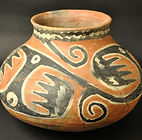The Jim and Vanita Oelschlager
Native American Ethnographic Collection
"Connecting Objects to their People: From the Arctic to Arizona"
Southwest: Land and People
The climate of the Southwest is a continuation of the Great Basin, only warmer. Its geography includes mountains, seasonal streams, a few rivers, and semi- to arid-desert areas. Some regions are warm all year, while others, in higher elevations, are cold and have snow, for example the north rim of the Grand Canyon and Flagstaff. In many areas the land is too dry for farming unless irrigated. Except for contemporary concentrations of urban populations such as Phoenix, Tucson, Santa Fe, and Albuquerque, the lands of southern Utah, Arizona, and New Mexico are still sparsely populated.
The early story of the Southwest is rich in archaeological evidence. Prior to the 1200s CE, there were areas of population clustered near streams and dependable seasonal water sources. In the dry climate, artifacts do not deteriorate rapidly, thus preserving evidence of prehistoric populations. Areas such as Mesa Verde (southern Colorado), Chaco Canyon (New Mexico), and Canyon de Chelly (Arizona) are important archaeological sites in the nation and provide amazing information about past life in those areas. These prehistoric villages were slowly abandoned in the 1300s, as there was less rain and warmer temperatures. The people, dependent on hunting and gathering of wild resources and minimal farming, dispersed in small groups and moved south. There their lifestyles changed to adapt to new environmental challenges. Farming with irrigation became a way to supplement hunting and gathering.
The Southwest was and still is home to many diverse native groups, some related by language and others migrants, such the Navajo and Apache from the north. There was contact between groups for centuries, with exchanges of ideas and materials.

The greatest changes, however, began with the arrival of Spanish missionaries and explorers in 1540, followed by the United States’ military and settlers. This changed the lives of the native peoples forever. Southwest native peoples have successfully struggled to maintain their cultural heritages and adapt to European/American political pressure for six centuries.
This exhibit contains objects from the early migration period to the present. These objects represent a continuous flow of ideas, styles, and technology from about 1100 CE to the present.
Three types of cultural materials featured in the Southwest section of this exhibit are pottery, weaving, and tools and ceremonial objects. The pottery represents both ancient and modern pottery-making traditions. The weavings are rugs of the early twentieth century, duplicating and adapting patterns from two prior centuries. The third group represents objects used by many native peoples of the Southwest, such as tools, ceremonial and trade objects.


